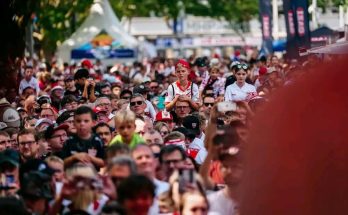The University of Alabama has never been short on attention during the offseason, but 2025 brings a new kind of focus. For the first time in nearly two decades, the Crimson Tide are entering the summer without Nick Saban at the helm. In his place stands Kalen DeBoer, a man who has experienced success at nearly every level and now carries the immense responsibility of maintaining—and redefining—one of college football’s most storied dynasties.
As the first offseason program under DeBoer winds down and summer workouts loom, the new Alabama head coach is optimistic. During a recent media availability, DeBoer expressed confidence in the roster as it stands, offering a glimpse into his approach and mindset as he steers the program into a new era. “We’re in a good spot,” DeBoer said. “We’ve been working hard, and we’re excited about the progress we’ve seen. The guys have bought in. They’ve responded to what we’re asking of them, and that’s all you can ask for.”
Those words might sound like coach-speak on the surface, but the context matters. Alabama’s roster was hit hard by the NFL Draft and the transfer portal following Saban’s retirement. The departures of key players like Jalen Milroe, Kool-Aid McKinstry, Dallas Turner, and JC Latham would be enough to rattle most programs. Instead, DeBoer has remained composed, methodically assembling a roster that blends holdovers from the Saban era, his own Washington staff, and a carefully curated crop of new talent via the portal and 2024 signing class.
One of the most compelling aspects of DeBoer’s transition is how he has navigated the balance between honoring Alabama’s traditions and injecting his own culture. During spring practice, there were no radical overhauls—no promises of reinventing the wheel. DeBoer understands the foundation is already strong. His job, as he sees it, is to reinforce it with clarity, discipline, and a fresh perspective that still pays homage to what came before.
A major factor in DeBoer’s confidence lies in the way returning players have embraced the transition. Leadership has emerged organically within the locker room, with veterans taking it upon themselves to set the tone. “These guys have pride,” DeBoer noted. “They know what Alabama football means, and they want to be the ones to keep that standard alive. We’re not trying to be someone else—we’re trying to be the best version of ourselves.”
At quarterback, the Crimson Tide are looking to fill the void left by Milroe, who declared for the NFL Draft after an electric 2024 campaign. While no starter has been named, the spring competition between Ty Simpson, Austin Mack, and incoming freshman Julian Sayin has provided the staff with encouraging signs. Simpson, a redshirt junior, brings valuable experience and has shown steady development. Mack, who followed DeBoer from Washington, is still adjusting to the SEC’s pace, but his familiarity with the system is a major advantage. Sayin, the prized recruit from California, impressed during limited spring reps and is expected to be in the mix as summer unfolds.
The offensive line, long considered a cornerstone of Alabama football, is also in transition. The departure of Latham and other veterans forced the staff to re-evaluate their depth and development plans. DeBoer has made it clear that this unit will be a priority during summer conditioning. “We’ve got size, we’ve got strength, and now it’s about continuity and understanding what we’re asking them to do,” he said. “They’ve come a long way since January, but there’s still another level we need to get to.”
Alabama’s backfield, while less talked about, is quietly one of the most promising units on the team. Jam Miller and Justice Haynes both flashed during spring camp and are expected to take on larger roles. Haynes, in particular, has been lauded for his explosiveness and vision, qualities that should fit well into the new offensive scheme. Combined with a wide receiver group that returns Isaiah Bond and Kendrick Law while adding transfers from Washington, Alabama should have the tools to be dynamic—if the quarterback situation settles.
On defense, DeBoer inherited a talented, albeit somewhat inexperienced, unit. The departures of Turner, McKinstry, and others left some voids in the pass rush and secondary, but several rising stars are poised to step into the spotlight. Defensive coordinator William Inge, who also joined from Washington, is tasked with building a unit that can maintain Alabama’s reputation for physical, suffocating defense while integrating more flexibility and modern concepts.
Key figures on that side of the ball include linebacker Jihaad Campbell, edge rusher Keon Keeley, and cornerback Desmond Ricks. All three made significant strides during spring camp and are expected to play vital roles. “The talent is there,” DeBoer said. “It’s just about reps, about being in the fire and learning how to respond. That’s what summer and fall camp are going to be for.”
Perhaps what’s most striking about DeBoer’s early tenure is how quickly he has established credibility. Despite following a legend, there has been no sense of panic. Instead, there’s a quiet resolve—a belief that the work being done behind the scenes is just as important as the headlines and expectations. In many ways, DeBoer’s calm demeanor has served as a stabilizing force for a program undergoing seismic change.
Alabama fans, known for their passion and impatience, have also started to rally around their new coach. While the true test will come in the fall, early indications suggest that the locker room and the fan base are aligned in giving DeBoer a chance to make his mark.
Still, the road ahead is not without challenges. The SEC remains the most brutal gauntlet in college football, and Alabama’s 2025 schedule features several tests that will reveal the team’s identity quickly. A neutral-site opener against Wisconsin, a road trip to LSU, and home dates with Georgia and Tennessee provide little room for error. But DeBoer isn’t flinching.
“We’re going to play Alabama football,” he said. “That means showing up every week, being disciplined, being physical, and doing the little things right. It’s not about me. It’s about these players and what they believe they can accomplish.”
Recruiting will be another critical area to watch, and early returns are promising. Despite the transition, Alabama remains firmly in the mix for several top-tier prospects in the 2025 and 2026 classes. DeBoer and his staff have emphasized transparency and relationship-building, focusing less on hype and more on development. That approach is resonating with both players and high school coaches.
As the calendar flips toward summer, the Crimson Tide appear to be stabilizing under DeBoer’s guidance. Conditioning and strength training will dominate the next few months, but so will leadership development and cultural reinforcement. DeBoer has emphasized the importance of accountability, both on and off the field, as a central tenet of the new Alabama standard.
“There’s a responsibility that comes with wearing that jersey,” he said. “We talk about it all the time—not just being great players, but being great teammates, great students, great ambassadors for this program. That’s what it takes to win at this level.”
Ultimately, DeBoer knows that words and optimism only go so far. The fall will determine how effective this transition truly is. But as of now, the Alabama roster is in a “good spot,” and more importantly, the players believe it. In a world where change often brings chaos, DeBoer has brought stability. The question now is whether that foundation will be strong enough to carry the Crimson Tide into a new golden era.
The pressure is immense. The legacy is undeniable. But if DeBoer’s first few months are any indication, Alabama football is not retreating from the spotlight—it’s simply learning to shine in a new way.



